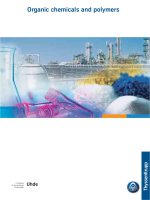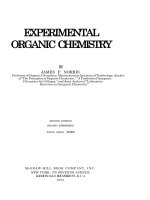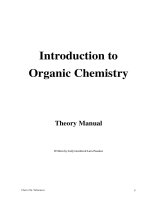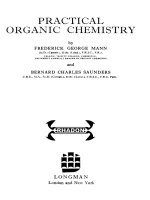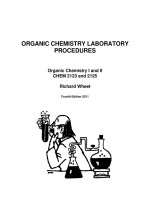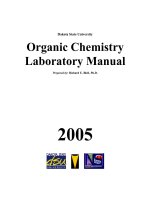ORGANIC CHEMISTRY LABORATORY PROCEDURES pdf
Bạn đang xem bản rút gọn của tài liệu. Xem và tải ngay bản đầy đủ của tài liệu tại đây (786.51 KB, 64 trang )
ORGANIC CHEMISTRY LABORATORY
PROCEDURES
Organic Chemistry I and II
CHEM 2123 and 2125
Richard Wheet
Fourth Edition 2011
This page left blank
ORGANIC CHEMISTRY LABORATORY PROCEDURES
Fourth Edition
RICHARD L. WHEET
Department of Chemical Technology
Texas State Technical College
2011
Copyright © 2011
Copyright © 2011, by Richard Wheet. All rights reserved. No part of this book may be
reproduced in any form, electronic or mechanical, including photocopy, recording, or any
information storage system, without permission in writing from the author.
REFERENCES
Morrison and Boyd, Organic Chemistry
Hajian, Modern Chemical Technology
This page left blank
TABLE OF CONTENTS
LABORATORY SAFETY
SIMPLE DISTILLATION OF A SINGLE SOLUTION 1
DISTILLATION OF A MIXTURE OF TWO LIQUIDS 5
FRACTIONAL DISTILLATION 9
MELTING POINT 13
PREPARATION OF ACETYL SALICYLIC ACID 17
EXTRACTION OF A KNOWN MIXTURE 21
EXTRACTION OF AN UNKNOWN MIXTURE 29
RECRYSTALLIZATION OF ACETANILIDE 35
SYNTHESIS OF ACETANILIDE 39
THE SYNTHESIS OF ESTERS 41
THE SYNTHESIS OF SOAP 45
ESSENTIAL OILS OF PLANTS 49
CHEMICAL TECHNOLOGY SAFETY INSTRUCTIONS
Laboratory work in chemistry can be stimulating to students who appreciate the challenge it
offers to their abilities, but it is not without certain hazards. For your safety, and for that of
your classmates, a few simple regulations will have to be enforced. The observance of
these safety regulations is an integral part of good laboratory technique.
1. Wear safety glasses at all times in the laboratory. This includes clean-up times and
times when you yourself may not be working on an experiment, but someone else
is.
2. Shoes must be worn in the laboratory. Sandals or bare feet are prohibited.
3. Shorts or cut-offs shall not be worn when working in the laboratory.
4. Light burners only when needed. Promptly extinguish any flame not being used. An
open flame may ignite reagents being used by you or others near you.
5. Do not eat, drink, smoke, dip or chew tobacco in the laboratory.
6. Never look directly into the mouth of an open flask or test tube if it contains a
reaction mixture.
7. Never point the open end of a test tube at yourself or at another person.
8. Avoid measuring volumes of strong acids or alkaline solutions with your graduated
cylinder held at eye level. Support the graduated cylinder on your bench; add the
hazardous liquids from a beaker a little at a time, inspecting after each addition.
9. Never weigh a chemical directly on a balance pan. Use a pre- weighed container,
e.g. a watch glass, weighing dish or a small square of clean paper turned up on all
sides.
10. Make sure all electrical equipment is safely grounded and all wires are insulated.
11. Report all accidents to your instructor.
SAFETY TEST
NAME OF STUDENT _______________________________
ADDRESS _______________________________
PHONE _______________________________
IN CASE OF AN ACCIDENT NOTIFY
ADDRESS _______________________________
PHONE _______________________________
1. The best first aid when a chemical gets into the eyes is to
___________ a) rub the eyes.
___________ b) wash the eye with clear water.
___________ c) put on safety glasses.
2. With proper precautions, any chemical can be handled safely.
___________ a) true
___________ b) false
___________ c) no opinion
3. The best way to learn hazardous characteristics of a chemical
is
___________ a) read the label on the bottle.
___________ b) ask your classmate.
___________ c) refer to your textbook.
___________ d) none of the above.
4. Safety glasses should be worn in the laboratory
___________ a) only when working with acids.
___________ b) only when working with bases.
___________ c) all of the time.
___________ d) only when heating a substance.
5. Horse play is permitted in the laboratory
___________ a) when cooling a chemical.
___________ b) when heating a chemical.
___________ c) during an experiment.
___________ d) never.
6. Accidents should be promptly reported to
___________ a) your partner.
___________ b) your other classmates.
___________ c) your instructor.
___________ d) the school nurse.
7. Burners should be lighted
___________ a) only when needed
___________ b) all the time.
___________ c) when cooling a chemical.
___________ d) never.
8. One should use the contents of an unlabeled container.
___________ a) always
___________ b) seldom
___________ c) never
___________ d) none of the above.
9. Foods, drinks, and smoking are permitted in a laboratory.
___________ a) never
___________ b) always
___________ c) once in a while
10. Which of the following are NOT required for a fire:
___________ a) oxygen
___________ b) fuel
___________ c) heat
___________ d) carbon dioxide
11. Unauthorized experiments are NOT to be performed.
____________ a) true
____________ b) false
____________ c) no opinion
12. Which of the following is a hazardous nature of chemicals?
___________ a) toxic
___________ b) flammable
___________ c) irritating
___________ d) explosive
___________ e) all of the above.
___________ f) none of the above.
13. Glassware which is chipped or cracked should be
___________ a) used right away.
___________ b) discarded
___________ c) given to your partner.
14. The proper way to dilute acid is to
___________ a) add acid and water at the same time.
___________ b) add acid to water.
___________ c) add water to acid
___________ d) none of the above.
15. Standing on a laboratory stool is a safe practice.
___________ a) true
___________ b) false
___________ c) no opinion
16. When dangerous gases are given off in a reaction, the
experiment should be carried out
___________ a) on your laboratory bench.
___________ b) outdoors.
___________ c) in a fume hood
___________ d) in the hallways.
17. It is a good practice to read the experiment and follow
the instructions carefully.
___________ a) true
___________ b) false
___________ c) no opinion
18. Excess reagents should be
___________ a) placed in a waste container.
___________ b) should be returned to the reagent
bottle.
___________ c) consumed by the student.
19. A chemical may enter the human body through the
___________ a) mouth.
___________ b) skin.
___________ c) lungs.
___________ d) all of the above.
20. Lids and stoppers should be replaced on the corresponding
reagent.
___________ a) true
___________ b) false
___________ c) no opinion
THIS IS TO CERTIFY THAT ________________________________________
I have received instruction on laboratory safety and have witnessed a safety film. I certify that I
understand the safety instructions and I am aware that safety glasses must be worn at all times in
the laboratory.
SIGNED _____________________________ DATE _____________________
Student
SIGNED _____________________________ DATE _____________________
Student Witness
THIS IS TO CERTIFY THAT ________________ has been given safety instructions and has
satisfactorily passed a safety test.
SIGNED ______________________________ DATE _____________________
Instructor
This page left blank
1
SIMPLE DISTILLATION OF A SINGLE SOLUTION
Distillation is a process where a liquid is vaporized, recondensed, and collected. Distillation
is used to purify liquids and to separate one liquid from another. The liquids have different
volatilies which is the relative ease with which the molecules of a liquid escape from the
surface. Volatility is normally the opposite of the boiling point of a liquid. The higher the
volatility of a liquid, the lower the boiling point. The lower the volatility of a liquid, the higher
the boiling point. Vapour pressure is a measure of the force a liquid exerts on the surface
for its molecule to escape.
The liquids will give off molecules, until the atmosphere above the liquid has a vapour
pressure equal to the respective temperature. For example, if the vapour pressure of a
liquid was 760 mm Hg at 60° C, molecules would escape from the surface until there was a
pressure of 760 mm Hg in the atmosphere vapour exerting pressure back at the liquid.
When a solvent is enclosed, the liquid will evaporate until the partial pressure of the gas
above the liquid equals the vapour pressure of the liquid. If some of the gaseous vapour is
removed, more liquid will evaporate in order to equalize the vapour pressure and partial
pressure. This is the principle behind distillation.
A liquid is heated in a distilling flask. The temperature of the liquid will increase (specific
heat) until the vapour pressure/temperature of the first liquid is reached. At this point, all
the heat energy (heat of vaporization) is used to evaporate the liquid. The hot vapour
2
travels upward and reaches a condensing column which removes heat from the vapour.
The gas recondenses back to a liquid and is collected in a receiving flask. Since this
reduces the vapour pressure over the liquid in the distilling flask, more liquid is converted to
vapour to equalize, which in turn recondenses. This is the general idea behind distillation.
If there is only one liquid in the receiving flask, it will be separated from any nonvolatile
solid. These solids would remain in the distillation flask. Thus, the liquid is purified.
EQUIPMENT & CHEMICALS
Water (H
2
0)
20% Sodium Chloride (NaCl)
Organic kit
EXPERIMENTAL OBJECTIVES
Describe the distillation process.
Perform a distillation.
PROCEDURE
1. Add 100 ml of aqueous 20% sodium chloride (NaCl) to a 200 ml distilling flask. In
picking a certain size of distilling flask, the volume of the flask should be about twice
the size of the volume of liquid.
2. Add 3 or 4 boiling chips to the flask to avoid bumping.
3. Assemble the distillation apparatus as shown in Fig 1-2. Remember to put a film of
silicon lubricant between the ground glass joints to prevent freezing of the joints.
The thermometer bulb should be slightly below the sidearm opening.
4. The upper outlet on the condenser should be for exiting cooling water. This will
prevent the accumulation of air in the condenser.
5. Turn on the cooling water.
6. Increase the heat to the distilling flask until the rate of distillate (liquid) into the
receiving flask is about 2-3 drops per second.
3
7. Record the temperature of
the vapour every 5 ml of
distillate collected.
8. Continue to distill until only
a small amount of residue
remains in the distilled
flask. Do not distill to
dryness.
9. What did you notice about
the temperature of the
vapor?
10. What did you observe
about the appearance of
the distilling flask after
distillation was almost
complete?
11. What can you say about
the relationship of the
boiling point of water
(theoretical) and your
experimental result?
4
DISTILLATION OF A MIXTURE OF TWO LIQUIDS
Simple distillation of a mixture of two liquids will not effect a complete separation. If both
liquids will boil, both will vaporize and be collected. The more volatile of the two liquids, will
vaporize more quickly than the less volatile and form a larger proportion of the distillate in
the receiving flask. When there is a large difference between the volatilities of the two
liquids, most of the first portion of the distillate collected will be almost pure. The last
portion will be purer in relation to the second liquid. The distillate collected in the middle will
contain varying amounts of the two (figure 2-1). You can separate the two liquids by
changing the receiving flask several times and numerous redistillations.
The first portion collected near the boiling point temperature of more volatile liquid will be
almost pure (compound A). The last portion collected when the temperature is nearly equal
to the boiling point of the less volatile will be mostly the less volatile liquid (compound B).
5
EQUIPMENT & CHEMICALS
Water (H
2
0)
Ethyl ether
Distillation Apparatus
EXPERIMENTAL OBJECTIVES
Describe the distillation process involving two liquids.
Perform a distillation.
PROCEDURE
1. Add 100 ml of a 25% ethyl ether/water mixture (v/v) to a 250 ml distilling flask. In
picking a certain size of distilling flask, the volume of the flask should be about twice
the size of the volume of liquid.
2. Add 3 or 4 boiling chips to the flask to avoid bumping.
3. Assemble the distillation apparatus as shown in fig 2-1. Remember to put a film of
silicon lubricant between the ground glass joints to prevent freezing of the joints.
The thermometer bulk should be slightly below the sidearm opening.
4. The upper outlet on the condenser should be for exiting cooling water. This will
prevent the accumulation of air in the condenser.
5. Turn on the cooling water.
6. Increase the heat to the distilling flask until the rate of distillate (liquid) into the
receiving flask is about 2-3 drops per second.
7. Record the temperature of the vapour every 5 ml of distillate collected.
8. Continue to distill until only about 40 ml remains in the distillation flask. Do not distill
to dryness.
6
9. What did you notice about
the temperature of the
vapor?
10. What can you say about
the relationship of the
boiling points of water and
ethanol (theoretical) and
your experimental result?
11. Draw a graph of volume
versus temperature and
explain the findings.
7
This page left blank
8
FRACTIONAL DISTILLATION
A simple distillation usually gives a crude distillation where the initial distillate has to be
redistilled to reach optimum purity. The separation and purification of two or more liquids
into various fractions by distillation is called fractional distillation. Fractional distillation is
really the systematic redistillation of the distillates within a column with the fractions
increasing in purity as the fractions move up the column. This is similar to repeatedly
collecting and redistilling the various fractions. The column is filled with pieces of glass,
glass beads, chips, metal wire, etc. These beads act as small condensers.
The vapour leaves the surface of the liquid and travels upwards through the packed
column. It condenses on the cooler beads and falls back as a liquid. The initial vapours
transfer heat to the lower beads. The recondensed vapour then vaporizes again but this
time move a little higher in the column and the process repeats. The less volatile vapours
reach the beads which were heated by the more volatile vapour. Since the temperature of
the beads are less than the boiling point of the less volatile vapour, they also recondense
and fall back. But this now heats the lower beads and the process continues. The more
volatile vapours pass through the column condensing and recondensing. But as the higher
boiling vapours heat the lower beads, these beads revaporize the higher volatile vapours
within the column. Thus the liquids do not return to the distillation flask as they move
upward.
Each repeated distillation causes a greater concentration of the more volatile liquid in the
rising vapour. The less volatile liquids also are in turn enriched as they pass upward
through the column.
CHEMICALS AND EQUIPMENT
Ethanol
Water
Distillation Apparatus
Glass beads
9
EXPERIMENTAL OBJECTIVES
The student should be able to perform a fractional distillation.
The student should be able to describe the process of fractional distillation.
PROCEDURE
1. Add 50 ml of ethanol and 100 ml of water to a 250 ml flask. Remember boiling
chips.
2. Fill a condenser with glass beads. If necessary, use a small plug of glass wool to
prevent the beads from falling through the column.
3. Assemble the fractionating column (Figure 1).
10
4. Slowly heat the distillate to a flow rate of 2-3 drops per minute.
5. Record the temperature versus the volume every 5 ml.
6. Plot a curve of volume versus temperature.
7. Explain how the results differ from a simple distillation.
11
This page left blank

